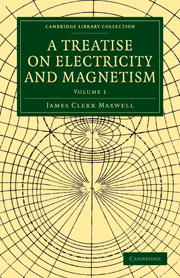Book contents
- Frontmatter
- PREFACE
- Contents
- ELECTRICITY AND MAGNETISM
- PRELIMINARY
- PART I ELECTROSTATICS
- CHAPTER I DESCRIPTION OF PHENOMENA
- CHAPTER II ELEMENTARY MATHEMATICAL THEORY OF ELECTRICITY
- CHAPTER III SYSTEMS OF CONDUCTORS
- CHAPTER IV GENERAL THEOREMS
- CHAPTER V MECHANICAL ACTION BETWEEN ELECTRIFIED BODIES
- CHAPTER VI POINTS AND LINES OF EQUILIBRIUM
- CHAPTER VII FORMS OF EQUIPOTENTIAL SURFACES AND LINES OF FLOW
- CHAPTER VIII SIMPLE CASES OF ELECTRIFICATION
- CHAPTER IX SPHERICAL HARMONICS
- CHAPTER X CONFOCAL SURFACES OF THE SECOND DEGREE
- CHAPTER XI THEORY OF ELECTRIC IMAGES
- CHAPTER XII CONJUGATE FUNCTIONS IN TWO DIMENSIONS
- CHAPTER XIII ELECTROSTATIC INSTRUMENTS
- PART II ELECTROKINEMATICS
- Plate section
CHAPTER XIII - ELECTROSTATIC INSTRUMENTS
Published online by Cambridge University Press: 05 July 2011
- Frontmatter
- PREFACE
- Contents
- ELECTRICITY AND MAGNETISM
- PRELIMINARY
- PART I ELECTROSTATICS
- CHAPTER I DESCRIPTION OF PHENOMENA
- CHAPTER II ELEMENTARY MATHEMATICAL THEORY OF ELECTRICITY
- CHAPTER III SYSTEMS OF CONDUCTORS
- CHAPTER IV GENERAL THEOREMS
- CHAPTER V MECHANICAL ACTION BETWEEN ELECTRIFIED BODIES
- CHAPTER VI POINTS AND LINES OF EQUILIBRIUM
- CHAPTER VII FORMS OF EQUIPOTENTIAL SURFACES AND LINES OF FLOW
- CHAPTER VIII SIMPLE CASES OF ELECTRIFICATION
- CHAPTER IX SPHERICAL HARMONICS
- CHAPTER X CONFOCAL SURFACES OF THE SECOND DEGREE
- CHAPTER XI THEORY OF ELECTRIC IMAGES
- CHAPTER XII CONJUGATE FUNCTIONS IN TWO DIMENSIONS
- CHAPTER XIII ELECTROSTATIC INSTRUMENTS
- PART II ELECTROKINEMATICS
- Plate section
Summary
On Electrostatic Instruments
The instruments which we have to consider at present may be divided into the following classes:
(1) Electrical machines for the production and augmentation of electrification.
(2) Multipliers, for increasing electrification in a known ratio.
(3) Electrometers, for the measurement of electric potentials and charges.
(4) Accumulators, for holding large electrical charges.
Electrical Machines
207.] In the common electrical machine a plate or cylinder of glass is made to revolve so as to rub against a surface of leather, on which is spread an amalgam of zinc and mercury. The surface of the glass becomes electrified positively and that of the rubber negatively. As the electrified surface of the glass moves away from the negative electrification of the rubber it acquires a high positive potential. It then comes opposite to a set of sharp metal points in connexion with the conductor of the machine. The positive electrification of the glass induces a negative electrification of the points, which is the more intense the sharper the points and the nearer they are to the glass.
When the machine works properly there is a discharge through the air between the glass and the points, the glass loses part of its positive charge, which is transferred to the points and so to the insulated prime conductor of the machine, and to any other body with which it is in electric communication.
- Type
- Chapter
- Information
- A Treatise on Electricity and Magnetism , pp. 254 - 287Publisher: Cambridge University PressPrint publication year: 2010First published in: 1873



